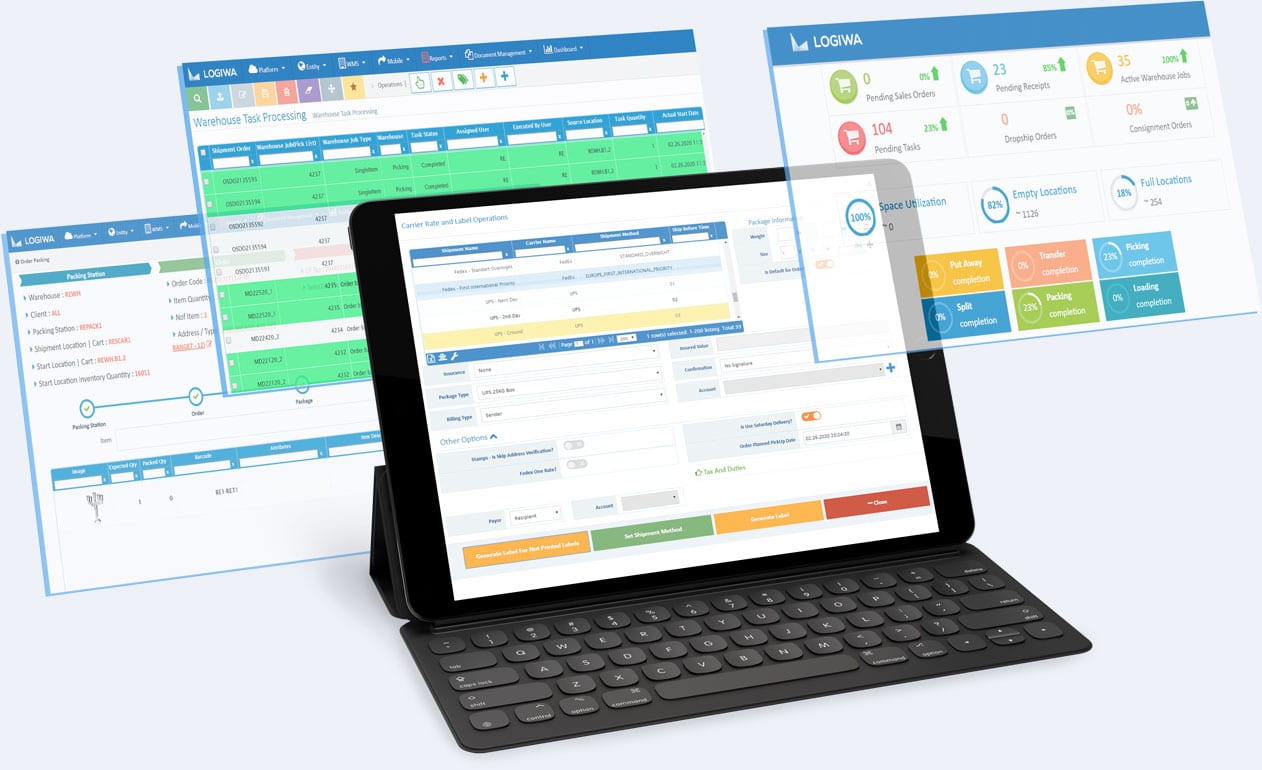Achieving competitive fulfillment results, surpassing customer expectations, and expanding your warehouse into a full-fledged fulfillment network are all key goals to maintain as your business takes on more inventory and growing ecommerce orders. But the key to direct-to-consumer (DTC) fulfillment success is no longer just a matter of optimizing your warehouse layout or adding robots to your warehouse floor—it’s about mastering warehouse data.
In this blog, we will discuss the key benefits of leveraging warehouse data with reporting and analytics to improve high-volume direct-to-consumer (DTC) success.
Contents
Key Takeaways:
- Data visibility helps fulfillment operations make sense of operational data, assess operational health, and make informed decisions that empower business growth.
- Combining warehouse data with robust reporting and analytics solutions offers valuable opportunities to eliminate costly inefficiencies, optimize workflows, improve inventory management, and expedite picking and packing processes.
- Warehouse analytics and reporting helps with meeting steep fulfillment requirements, demand, and internal supply chain needs by providing real-time insights.
- Key benefits of leveraging analytics include: the ability to forecast consumer needs, improve inventory accuracy, optimize supply chain management, optimize labor efficiency and space utilization, simplify multi-client operations and adapt to seasonal trends.
- Proper data collection gives a holistic snapshot of high-volume DTC operations to ensure operations are getting the most out of their technology, strategies and partnerships.
The Importance of Warehouse Data Visibility
Having good warehouse visibility and data management is more than just getting notified when something goes wrong on the warehouse floor. Proper data visibility covers a much larger scope and helps you make sense of all the operational data at your disposal, assess the health of your operation, and make informed decisions that empower your business.
For warehouse operators and third party logistics (3PL) providers, data visibility is especially crucial for managing high-volume direct-to-consumer (DTC) fulfillment operations. Combining warehouse data with robust reporting and analytics solutions offers valuable opportunities to eliminate costly inefficiencies, optimize workflows, improve inventory management, and expedite picking and packing processes.
If you run a multi-warehouse operation, the need for data management is even greater. After all, the interconnectedness of modern fulfillment networks means that one setback or delay at any point in your operations can quickly cause issues elsewhere. That’s why, to achieve fulfillment excellence, you must find ways to navigate and leverage all the actionable data flowing through your supply chain operations.
Warehouse Reporting and Analytics for DTC Operations
If you do not currently have a data-driven approach to warehousing, it’s not a matter of if you’re losing efficiency and money—but where. Your ability to capture, interpret, and act on operational data is a key determinant in the success of your fulfillment operations and chosen fulfillment solutions. After all, data analytics can tell you where you are excelling and where you need improvement.
When it comes to warehouse data, reporting and analytics work to identify inefficiencies and prevent them from having the chance to occur. They tell you exactly where your business is excelling and where there’s room to improve in virtually every category: from inventory levels, incoming orders, labor productivity, billing information, and even the status of your hardware.
Warehouse analytics and reporting technology help you stay ahead of steep fulfillment requirements, demand predictions, and internal supply chain needs by giving you real-time access to quality data: the most powerful tool you have for on-the-go order management and problem solving.

Transform your warehouse to a DTC fulfillment center
8 Ways to Leverage Reporting and Analytics for DTC Fulfillment
- Demand Forecasting. Overselling stock or carrying too much inventory decreases cash flow and increases your warehouse expenses. But with predictive analytics using your historical warehouse data to predict demand, you are able to maintain strategic inventory levels and plan effectively for busy seasons.
- Accurate Inventory Management. DTC operations require flawless inventory processes in order to work. With analytics software, your warehouse data and inventory information can be configured to not only improve the organization or categorization of your inventory items, but upgrade your putaway operations, smooth picking and packing processes, and ensure replenishment functions are working as well. It also helps lower the number of lost, stolen or broken items, inaccurate inventory levels, and other system discrepancies.
- Supply Chain Management. Analytics helps you to avoid supply chain mishaps, which allows you to be able to cultivate better, long-lasting relationships with all your fulfillment partners. This helps make today’s consumers’ steep fulfillment requirements possible (ex. same-day and next-day delivery) because it helps your suppliers, warehouse staff, shippers and carriers are all on the same page.
- Better Labor Management: One of the biggest costs to DTC operations is ineffective labor management. Analytics can help optimize walking paths, pick orders, and facility management to improve worker conditions, team productivity and overall resource allocation (especially if you are also using robots!) to save money and improve employee satisfaction.
- Optimized Space Utilization. Using analytics to map out a digital warehouse of your organization, you are able to lay out your facilities in a way that makes it much easier for pickers to locate products, move facilities around as your operations evolve, and improve fulfillment processes based on the identification of bottlenecks, incoming products, and more.
- Multi-Client Operations: Analytics and reporting technology sets you up to manage multiple business profiles, billing data, and various suppliers with ease. No more guessing about whether or not your warehouse is working efficiently. You will be able to offer them timely insights on the status of operations and provide reports that show reduced damaged goods, improved delivery times, and successful delivery results.
- Get the Most Out of Your Technology: Analytics often come as a part of your warehouse management systems (WMS) solution. For that reason, they can often provide insights on your devices and equipment scalability, or whether your hardware and softwares configurations are working as they should be. Moreover, telematic data allows your warehouse operators to monitor essential equipment. (e.g., the impacts, usage times, battery life of forklift controls, brakes, robots, etc.) to avoid preventable delays.
- Adapting to Seasonal Demand: Whether it has to do with peak season order volumes or bringing on more warehouse workers to get the job done, warehouse management analytics and reporting can help you know exactly how to form a strategic approach for success. By studying historical data and monitoring your current operations in real-time, you can feel confident your warehouse is prepared for every month of the year.
We highlight eight peak season pitfalls in this article for ecommerce brands and 3PL providers face when preparing for the busiest time of year.
Data collected from various points along your workflows and throughout your fulfillment network gives you a holistic snapshot of your high-volume DTC operations. Choose a WMS that already comes pre-build with analytics and reporting engines, to ensure you’re getting the most out of your technology and supply chain operations.
DTC Analytics—Reporting and Analytics Made Easy with Logiwa WMS
Your ability to manage, interpret, and use your operational data will be a key determinant in the success of your fulfillment network. In other words, if you aren’t making data-driven decisions, you are acting against operational efficiency—a huge disadvantage over new market leaders.
Logiwa WMS’s Analytics feature analyzes your warehouse management data, so you don’t have to. At Logiwa, we understand the importance of choosing the right solution to manage and protect your operational data. That’s why we developed a Cloud fulfillment platform complete with AI and machine learning capabilities designed specifically for high-volume fulfillment operations. Our warehouse management systems (WMS)’s leading AI technology makes us the top solution for DTC order management.
No matter the size of your warehouse, our systems can meet your unique needs and challenges in as little as four weeks. With advanced analytics and built-in automation tools, and the ability to integrate with virtually any robotics, ecommerce, shipping and ERP solutions, our platform was designed with highly configurable algorithms to meet your unique operational needs.
Logiwa’s WMS can help in areas such as:
- Forecasting
- Workforce management and training
- Picking, packing, putaway, replenishment, and shipping
- Inventory management, including fixing out-of-stock problems
- Warehouse layout
- Automating workflows based on historical and current data
- Improved analytics to help you make informed business decisions
Learn more about Logiwa Analytics.
FAQs about Warehouse Data & Analytics
How can I leverage data analytics to improve my warehouse operations?
Analyzing warehouse data can help you to optimize inventory levels (and stock allocation), streamline logistics, and enhance order fulfillment processes, leading to cost savings and improved customer satisfaction. When leveraged correctly, data analytics can root out inefficiencies in workflows and lead to more strategic decision-making, operational stability and long-term growth.
How does warehouse data analytics work?
Warehouse analytics monitor real-time operational data to generate actionable insights based on perceivable trends. This can include tracking orders, inventory levels, shipping data, fulfillment accuracy rates, custom KPIs, and so on. Utilizing robust algorithms and statistical models, these solutions deliver easily digestible insights through dashboards and reports.
How do I get started implementing warehouse data and analytics into my business?
Leading WMS and fulfillment solutions often include analytics as part of their platform. Choose a standalone solution, or platform with built-in BI tools, capable of supporting your operational goals. Then, create data-driven processes, train your team, and regularly monitor and refine your analytics strategies to drive continuous improvement in your warehouse operations.





